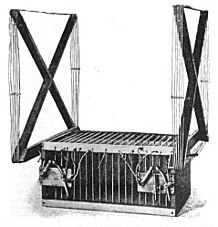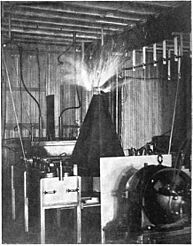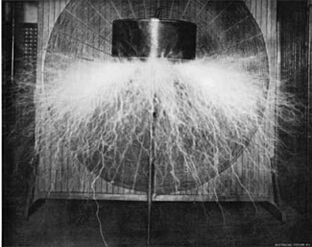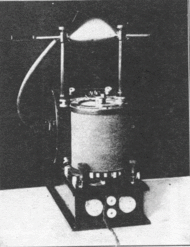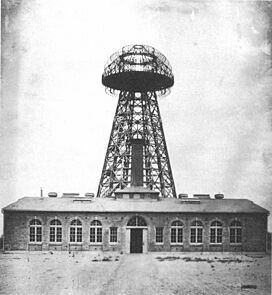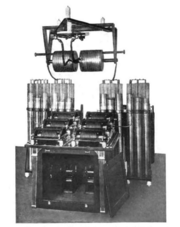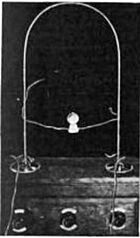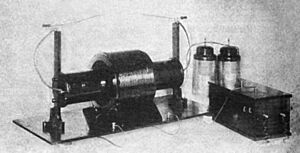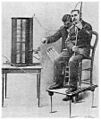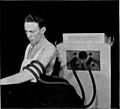History of the Tesla coil facts for kids
The Tesla coil is a special electrical circuit invented by Nikola Tesla. He received a patent for it on April 25, 1891. Tesla first showed it to the public on May 20, 1891. This happened during a talk at Columbia College in New York. His talk was about "Experiments with Alternate Currents of Very High Frequency."
Even though Tesla patented many similar circuits, this was the first one that had all the key parts of a Tesla coil. These parts include a high voltage primary transformer, a capacitor, a spark gap, and an air core "oscillation transformer."
Contents
How Was the Tesla Coil Invented?
During the Industrial Revolution, electricity was mostly direct current (DC) or low frequency alternating current (AC). Not much was known about very high frequencies, which we now call radio frequencies. In 1887, Heinrich Hertz discovered radio waves. These were electromagnetic waves that vibrated at very high frequencies. This discovery made many scientists interested in high frequency currents.
Tesla was an expert in AC power systems. He understood how transformers and resonance worked. In 1888, he decided that high frequencies were the best area for his research. He set up a lab in New York to study them.
At first, he used alternators to create high frequency currents. But by 1890, these machines could only reach about 20,000 vibrations per second (20 kHz). To get even higher frequencies, he started using circuits that created sparks. Tesla's big idea was to use resonance with transformers. Transformers work differently at high frequencies. The iron core in low frequency transformers caused energy loss. Tesla and Elihu Thomson both developed a new type of transformer without an iron core. They called it an "oscillation transformer." The Tesla coil circuit was designed to power this transformer to make very high voltages.
Tesla invented the Tesla coil while trying to create a "wireless" lighting system. He wanted to make gas discharge light bulbs glow in an electric field. This field would come from a high voltage, high frequency power source. He found that high frequency currents made the iron core in his old coils overheat. To fix this, he removed the iron core and added an air gap between the wires. He also added a capacitor to the circuit. By adjusting the coil and capacitor, Tesla found he could use resonance to get even higher frequencies. He realized that the highest voltages were made when the "closed" primary circuit (with the capacitor) was in resonance with the "open" secondary winding.
-
A small coil designed by Tesla to make ozone for water treatment.
Tesla was not the very first to build a similar circuit. Henry Augustus Rowland made a spark-excited resonant transformer in 1889. Elihu Thomson also experimented with similar circuits in 1890. However, Tesla was the first to see how useful it could be and to get a patent for it. Tesla didn't do complex math for his circuit. He used trial and error and his good understanding of resonance. He even knew that the secondary coil worked like a quarter-wave resonator. This meant the length of the wire in the secondary coil needed to be a quarter of the wavelength at the resonant frequency.
Tesla's Amazing Demonstrations
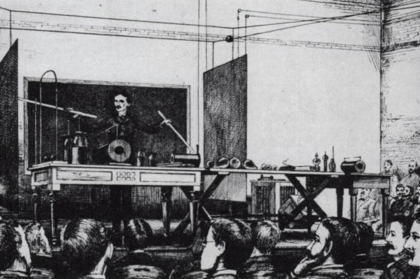
Tesla was a great showman. From 1891 to 1893, he used the Tesla coil in exciting public lectures. He showed off the new science of high voltage, high frequency electricity. The radio frequency AC currents from a Tesla coil acted differently from the DC or low frequency AC currents that scientists knew. In his lectures, he amazed audiences with huge sparks and glowing streams of electricity. He heated iron using induction heating. He showed that RF current could pass through materials that usually block electricity. He also powered light bulbs and motors without wires.
He even showed that high frequency currents often did not cause an electric shock. He applied hundreds of thousands of volts to his own body. This made his body glow with a corona discharge in the dark room. These lectures introduced the "Tesla oscillator" to the scientific world. They made Tesla famous around the globe.
Experiments with Wireless Power
Tesla used the Tesla coil in his dream to achieve wireless power transmission. From 1891 to 1900, he did some of the first wireless power experiments. He sent radio frequency power short distances using inductive coupling between coils. In his early shows, he lit light bulbs across a room. He found he could send power further by using a receiving circuit tuned to resonance with his Tesla coil. This method is called resonant inductive coupling.
At his Colorado Springs lab in 1899–1900, he used a huge "magnifying transmitter" coil. This coil made about 10 million volts. He was able to light three light bulbs about 100 feet (30 meters) away. Today, resonant inductive coupling is used in many electronic devices. For example, it's used in cellphone charging pads.
Scientists now understand that inductive coupling and capacitive coupling are "near-field" effects. This means they cannot be used for long-distance power transmission. However, Tesla believed he could build a system to send power directly to homes and factories without wires. He thought the whole Earth could act like an electrical resonator. He imagined sending current pulses into the Earth at its resonant frequency. This would make the Earth's electrical potential vibrate, creating global standing waves. This alternating current could then be received anywhere on Earth.
Tesla dreamed of building a global network of wireless power stations. He called this his "World Wireless System." It would send both information and electric power to everyone. But there is no clear proof that he ever sent large amounts of power over long distances.
The Magnifying Transmitter
Tesla's wireless research needed higher and higher voltages. He had reached the limit of what he could do in his New York lab. So, between 1899 and 1900, he built a lab in Colorado Springs. He chose this place because he could get all the power he needed for free. The Colorado Springs lab had one of the biggest Tesla coils ever built. Tesla called it a "magnifying transmitter." It was meant to send power to a distant receiver.
With 300 kilowatts of power, it could make about 10 million volts. This created huge "lightning bolts" up to 135 feet (41 meters) long. During one experiment, it caused an overload that broke the power company's generator. Tesla had to rebuild it.
The magnifying transmitter used a special design. It had a primary coil (L1) and a secondary coil (L2). It also had a third coil (L3), called the "extra" coil. This extra coil was not directly connected to the others. When powered by the secondary coil, it made even higher voltage through resonance. This design was similar to the Oudin coil, which was discovered by Paul Marie Oudin in 1893.
The Colorado Springs machine had a 51-foot (15.5 meter) diameter Tesla transformer. Its secondary coil (L2) had 50 turns of thick wire. It was wound on a 6-foot (2 meter) high wooden "fence" around the lab. The primary coil (L1) had a single turn. It was connected to a bank of oil capacitors (C1) and a rotary spark gap (SG). The top of the secondary coil was connected to the 100-turn, 8-foot (2.4 meter) diameter "extra" coil (L3). This coil was in the center of the room. Its high-voltage end was connected to a 143-foot (43.6 meter) "antenna" rod. This rod had a 30-inch (1 meter) metal ball on top. It could go through the roof of the lab. Tesla could adjust the rod to tune the circuit to resonance.
The Wardenclyffe Tower
In 1901, Tesla believed his wireless ideas were right. With money from banker J. P. Morgan, he started building a high-voltage wireless station. It is now called the Wardenclyffe Tower, located in Shoreham, New York. It was built as a transatlantic radiotelegraphy station. But Tesla also wanted it to send electric power without wires. It was meant to be a test transmitter for his "World Wireless System."
The tower was essentially a giant Tesla coil. It had a powerhouse with a 400-horsepower generator. The tower itself was 187 feet (57 meters) tall. It was topped by a 68-foot (21 meter) metal dome. The circuit he used was a version of his "magnifying transmitter." Under the ground, there was a complex ground system. Tesla said this was needed to "grip the earth" and create the oscillating earth currents he believed would transmit power.
By 1904, his investors stopped funding the project. The facility was never finished and was torn down in 1916. Although Tesla seemed to believe his wireless power ideas were proven, there is no clear evidence that he ever sent significant power beyond short distances. The stories of him lighting 200 light bulbs 26 miles (42 km) away are not confirmed. This story came from his first biographer in 1944, who put it together from "fragmentary material."
Even today, scientists say his World Wireless system would not have worked. Tesla's coils can work as radio transmitters. But the frequency he used (around 150 kHz) is too low for practical long-range power transmission. At these wavelengths, radio waves spread out in all directions. They cannot be focused on a distant receiver. Tesla's dream of worldwide power transmission remains a fascinating idea.
How Tesla Coils Were Used in Early Radio
One of the biggest uses for the Tesla coil circuit was in early radio transmitters. These were called spark gap transmitters. The first radio wave generators, invented by Heinrich Hertz in 1887, were simple spark gaps connected to antennas. They produced very damped radio waves. This meant their signals spread across many frequencies. If many transmitters were in the same area, their signals would overlap. This caused jumbled reception.
In 1892, William Crookes, a friend of Tesla, suggested using resonance to make radio signals narrower. With resonant circuits, different transmitters could send signals on different frequencies. This would stop them from interfering with each other. This is the system used in all modern radio today.
With the right antenna, the Tesla coil circuit could work as a narrow-bandwidth radio transmitter. In his March 1893 lecture, Tesla showed a wireless system. It was the first to use tuned circuits in radio. He used it for wireless power, not communication. A grounded Tesla transformer with an elevated wire antenna sent out radio waves. These waves were received across the room by another antenna connected to a receiver. This receiver was also a grounded resonant transformer tuned to the same frequency. It lit a Geissler tube. This system, patented by Tesla in 1897, was an early version of the "four-circuit" idea later claimed by Guglielmo Marconi. However, Tesla was more interested in wireless power and never built a practical radio communication system.
Practical radiotelegraphy communication systems were developed by Marconi starting in 1895. By 1897, people realized the benefits of narrow-bandwidth systems. Resonant circuits, capacitors, and inductors were added to transmitters and receivers. The "closed primary, open secondary" resonant transformer circuit used by Tesla was a better transmitter. It helped reduce the signal's damping, allowing it to produce longer, "ringing" waves with a narrower bandwidth. Versions of this circuit were patented by Marconi, John Stone Stone, and Oliver Lodge. They were widely used in radio for 20 years.
Around 1920, spark transmitters became old-fashioned. They were replaced by vacuum tube transmitters. These new transmitters made continuous waves at a single frequency. These waves could also be changed to carry sound. Tesla's resonant transformer continued to be used in vacuum tube transmitters and receivers. It is still a key part of radio today.
During the "spark era," radio engineers gave credit to Tesla. His circuit became known as the "Tesla coil" or "Tesla transformer." However, Tesla did not make much money from it due to patent disputes. In 1943, the US Supreme Court said that Marconi's 1900 patent claim to the "four circuit" idea was not valid. The court mentioned the earlier patents of Tesla, Lodge, and Stone.
Tesla Coils in Entertainment
The Tesla coil's amazing sparks and its ability to pass current through the human body without causing electric shock made it popular in entertainment.
In the early 1900s, Tesla coils appeared in traveling carnivals and sideshows. Performers like "Dr. Resisto" or "The Human Dynamo" would connect their bodies to a hidden Tesla coil. This made sparks shoot from their fingertips. Neon lights and fluorescent tube lamps would light up when brought near them. They could even light candles or cigarettes with their fingers. These acts were very dangerous. If the Tesla coil was not set up correctly, it could kill the performer. Today, entertainers still use Tesla coils for shows. But allowing current to pass through the body is now considered extremely dangerous.
Tesla coils were also used as exciting props in early mystery and science fiction motion pictures. The crackling sparks from a giant Tesla coil became a famous symbol of a "mad scientist's" lab in Hollywood. This was probably because Nikola Tesla himself, with his famous high voltage shows and mysterious lab, was one of the inspirations for the "mad scientist" character.
Some early films that featured Tesla coils include Metropolis (1927) and Frankenstein (1931). Many later films and TV shows also used them. By the 1980s, effects like high voltage sparks were added to movies using CGI. This removed the need for dangerous high voltage Tesla coils on movie sets.
Kenneth Strickfaden (1896-1984) built the Tesla coils for many of these movies. He became Hollywood's top electrical special effects expert. His large "Meg Senior" Tesla coil could make 6-foot (1.8 meter) sparks. Some of his last jobs included rebuilding the original 1931 Frankenstein equipment for the movie Young Frankenstein (1974). He also built a million-volt Tesla coil for a 1976 stage show by the rock band Kiss.
Tesla Coils in Education
Since Tesla's lectures in the 1890s, Tesla coils have been popular attractions in educational exhibits and science fairs. They help show that science can be exciting. In the early 1900s, experts like Henry Transtrom and Earle Ovington gave high voltage demonstrations at "electric fairs." High school classes even built their own Tesla coils.
From 1933 into the 1980s, Hollywood special effects expert Ken Strickfaden toured with his high voltage equipment. His show, called "Science on Parade," visited high schools, colleges, and World Fairs. These amazing shows inspired many people to build their own Tesla coils.
One of the oldest and most famous working Tesla coils is the "GPO-1" at Griffith Observatory in Los Angeles. It was built in 1910 by Earle L. Ovington, a friend of Tesla. Ovington used to display it at electrical trade shows in New York City. Tesla himself sometimes attended these shows. The "Million Volt Oscillator" would create 10-foot (3 meter) arcs for the public. In 1937, Ovington donated the coils to the Griffith Observatory. One coil was restored by Kenneth Strickfaden and has been working daily ever since. It can produce an estimated 1.3 million volts.
Later Uses of Tesla Coils
Besides their use in early radio transmitters and medicine, Tesla coil circuits were also used in the early 1900s in x-ray machines, ozone generators for water cleaning, and induction heating equipment. However, in the 1920s, vacuum tube oscillators replaced them in most of these uses. Vacuum tubes were better at making radio frequency currents.
After this, industrial use of the Tesla coil was mainly for special jobs. For example, they were used for testing how well high voltage insulation worked.
In 1926, physicists Merle Tuve and Gregory Breit built a 5 million volt Tesla coil. They used it as a linear particle accelerator. This coil was operated in a tank of insulating oil under high pressure. It could reach 5.2 million volts. While it was used for a short time, it wasn't very successful.
In 1970, Robert K. Golka built a copy of Tesla's huge Colorado Springs magnifying transmitter. He used information from Tesla's lab notes. This coil made 12 million volts. Golka used it to try and recreate Tesla's reported ball lightning experiments.
Images for kids
-
Electrotherapy treatment of diabetes with a vacuum electrode, 1922.


